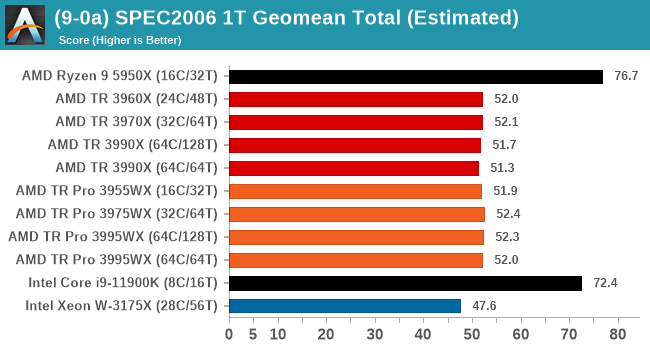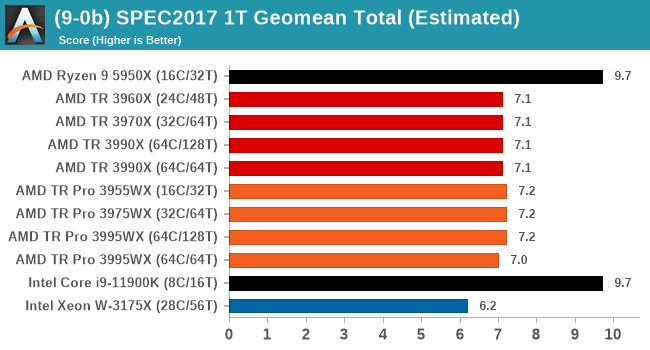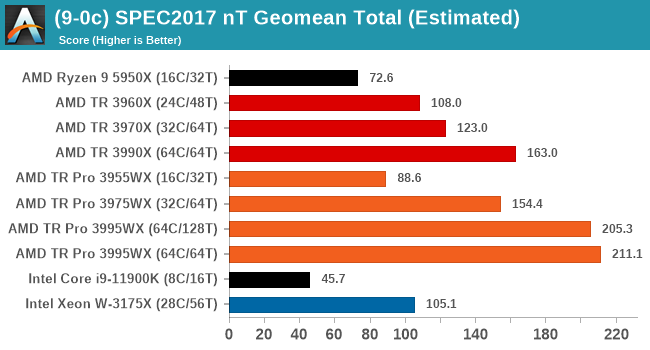AMD Threadripper Pro Review: An Upgrade Over Regular Threadripper?
by Dr. Ian Cutress on July 14, 2021 9:00 AM EST- Posted in
- CPUs
- AMD
- ThreadRipper
- Threadripper Pro
- 3995WX
CPU Tests: SPEC
SPEC2017 and SPEC2006 is a series of standardized tests used to probe the overall performance between different systems, different architectures, different microarchitectures, and setups. The code has to be compiled, and then the results can be submitted to an online database for comparison. It covers a range of integer and floating point workloads, and can be very optimized for each CPU, so it is important to check how the benchmarks are being compiled and run.
We run the tests in a harness built through Windows Subsystem for Linux, developed by our own Andrei Frumusanu. WSL has some odd quirks, with one test not running due to a WSL fixed stack size, but for like-for-like testing is good enough. SPEC2006 is deprecated in favor of 2017, but remains an interesting comparison point in our data. Because our scores aren’t official submissions, as per SPEC guidelines we have to declare them as internal estimates from our part.
For compilers, we use LLVM both for C/C++ and Fortan tests, and for Fortran we’re using the Flang compiler. The rationale of using LLVM over GCC is better cross-platform comparisons to platforms that have only have LLVM support and future articles where we’ll investigate this aspect more. We’re not considering closed-sourced compilers such as MSVC or ICC.
clang version 10.0.0-svn350067-1~exp1+0~20181226174230.701~1.gbp6019f2 (trunk)
-Ofast -fomit-frame-pointer
-march=x86-64
-mtune=core-avx2
-mfma -mavx -mavx2
Our compiler flags are straightforward, with basic –Ofast and relevant ISA switches to allow for AVX2 instructions. We decided to build our SPEC binaries on AVX2, which puts a limit on Haswell as how old we can go before the testing will fall over. This also means we don’t have AVX512 binaries, primarily because in order to get the best performance, the AVX-512 intrinsic should be packed by a proper expert, as with our AVX-512 benchmark. All of the major vendors, AMD, Intel, and Arm, all support the way in which we are testing SPEC.
To note, the requirements for the SPEC licence state that any benchmark results from SPEC have to be labelled ‘estimated’ until they are verified on the SPEC website as a meaningful representation of the expected performance. This is most often done by the big companies and OEMs to showcase performance to customers, however is quite over the top for what we do as reviewers.
For each of the SPEC targets we are doing, SPEC2006 rate-1, SPEC2017 rate-1, and SPEC2017 rate-N, rather than publish all the separate test data in our reviews, we are going to condense it down into a few interesting data points. The full per-test values are in our benchmark database.


Single thread is very much what we expected, with the consumer processors out in the lead and no real major differences between TR and TR Pro.

That changes when we move into full thread mode. The extra bandwidth of TR Pro is clear to see, even in the 32C/64T model. In this test we're using 128 GB of memory for all TR and TR Pro processors, and we're seeing a small bump when in 64C/64T mode, perhaps due to the increased memory cap/thread and memory bandwidth/thread as well. The 3990X 64C/128T run kept failing for an odd reason, so we do not have a score for that test.










98 Comments
View All Comments
Rocket_Scientist - Friday, July 16, 2021 - link
I want to know who spends 5 grand on a processor but doesn't spend the few extra dollars to utilize all 8 memory channels!Mikewind Dale - Friday, July 16, 2021 - link
The 3955WX processor "only" costs $1,150, while each stick of 64 GB RAM costs $350.And I wanted to keep some empty slots in case 128 GB RDIMMs became affordable. But I didn't know that using 6 channels would cause so much performance degradation.
mode_13h - Saturday, July 17, 2021 - link
> who spends 5 grand on a processor but doesn't spend> the few extra dollars to utilize all 8 memory channels!
Although I tend to agree, the article did reveal some benchmarks where the additional bandwidth provides negligible benefit.
lmh - Tuesday, July 27, 2021 - link
Can you share what memory bandwidth you actually measured in the 3955WX 8-channel configuration?McFig - Wednesday, July 14, 2021 - link
There’s an error in the table “AMD 32-Core Zen 2 Comparison”: The MSRPs are mixed up.McFig - Wednesday, July 14, 2021 - link
Also: “code bath”; “Undreal” (I’m guessing should be “Unreal”?); “but also the updates” (e.g. could be “but also there were significant updates”)SarahKerrigan - Wednesday, July 14, 2021 - link
I kind of like "Code Bath."Threska - Wednesday, July 14, 2021 - link
" This is part of AMD’s guaranteed supply chain process, allowing OEMs to hard lock processors into certain vendors for supply chain end-to-end security that is requested by specific customers."I ASSUME that's a feature a certain OS vendor can't access.
"Only select vendors seem to have access/licenses to make WRX80 motherboards, and your main options are:"
I've seen the Giga offered as a burn-in special with a bundled processor, making it a better deal. The Asus is nice but I have to wonder if it's worth all the features.
DesireeTR - Wednesday, July 14, 2021 - link
No, It's worse. There's article about AMD Platform Secure Boot Feature (PSB) by servethehome together with Dell EMC. It basically burns permanently a public key of the OEM into the EPYC processor. It creates a guarantee that both motherboard and processor are not tampered. If you move your processor from OEM A that enabled PSB to motherboard of OEM B, AMD Secure Processor considers that as tampering and stops it working. The reverse is true.Some OEM are very strict (Dell EMC does this by hardware burn-in), some are less strict (HPE use
DesireeTR - Wednesday, July 14, 2021 - link
HPE only locks the public key in the firmware, and perform tamper check on BIOS only). And I guess before long, all PRO processor might get the same PSB feature too.